清华大学新闻与传播学院新媒体研究课程教学计划(内部版)
新媒体艺术系教学工作计划

一、前言随着科技的飞速发展,新媒体艺术逐渐成为当代艺术的重要领域。
为了培养具有创新精神和实践能力的新媒体艺术人才,我系特制定以下教学工作计划。
二、教学目标1. 培养学生具备扎实的理论基础,了解新媒体艺术的发展历程、艺术观念和创作方法。
2. 提高学生的动手能力和实践能力,使学生能够熟练运用新媒体技术进行艺术创作。
3. 培养学生的审美素养和艺术鉴赏能力,使学生能够欣赏和评价新媒体艺术作品。
4. 培养学生的团队合作精神,使学生能够在团队项目中发挥积极作用。
三、教学内容1. 理论课程:(1)新媒体艺术概论:介绍新媒体艺术的发展历程、艺术观念和创作方法。
(2)数字图像处理:教授数字图像的采集、处理和编辑技巧。
(3)数字动画与特效:讲解数字动画的制作流程、特效技术及后期合成。
(4)虚拟现实与增强现实:介绍VR/AR技术及其在艺术创作中的应用。
(5)交互设计与用户体验:培养学生设计具有良好用户体验的交互作品。
2. 实践课程:(1)新媒体艺术创作:指导学生运用所学知识进行新媒体艺术创作,如数字绘画、数字雕塑、交互装置等。
(2)项目实践:组织学生参与实际项目,锻炼学生的实践能力和团队协作精神。
(3)作品展览:举办学生作品展览,提高学生的展示能力和自信心。
四、教学方法1. 讲授法:系统讲解新媒体艺术理论知识,为学生提供基础知识框架。
2. 案例分析法:通过分析优秀新媒体艺术作品,提高学生的审美能力和鉴赏水平。
3. 实践操作法:引导学生动手实践,掌握新媒体艺术创作技能。
4. 小组讨论法:鼓励学生积极参与课堂讨论,培养团队协作精神。
五、教学评估1. 平时成绩:包括课堂出勤、作业完成情况、实践操作等。
2. 考试成绩:理论课程采用闭卷考试,实践课程采用作品展示和答辩。
3. 评价方式:教师评价、学生互评、自我评价相结合。
六、教学资源1. 教材:选用国内外权威的新媒体艺术教材,确保教学内容与时俱进。
2. 实验室:配备先进的数字设备,为学生提供良好的创作环境。
新媒体传播方向课程设计
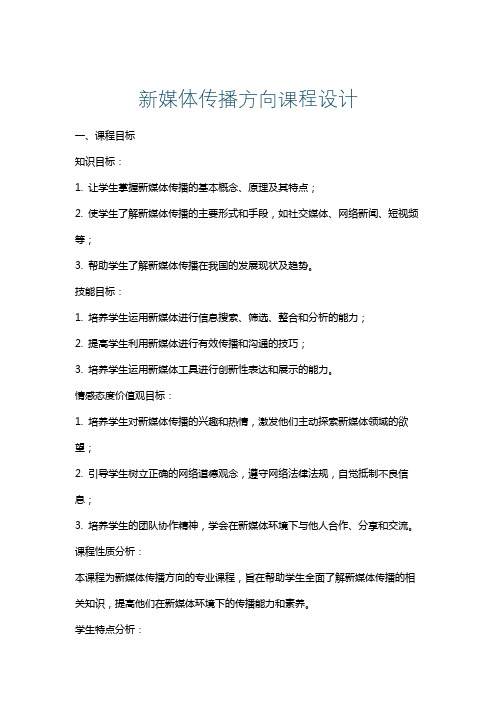
新媒体传播方向课程设计一、课程目标知识目标:1. 让学生掌握新媒体传播的基本概念、原理及其特点;2. 使学生了解新媒体传播的主要形式和手段,如社交媒体、网络新闻、短视频等;3. 帮助学生了解新媒体传播在我国的发展现状及趋势。
技能目标:1. 培养学生运用新媒体进行信息搜索、筛选、整合和分析的能力;2. 提高学生利用新媒体进行有效传播和沟通的技巧;3. 培养学生运用新媒体工具进行创新性表达和展示的能力。
情感态度价值观目标:1. 培养学生对新媒体传播的兴趣和热情,激发他们主动探索新媒体领域的欲望;2. 引导学生树立正确的网络道德观念,遵守网络法律法规,自觉抵制不良信息;3. 培养学生的团队协作精神,学会在新媒体环境下与他人合作、分享和交流。
课程性质分析:本课程为新媒体传播方向的专业课程,旨在帮助学生全面了解新媒体传播的相关知识,提高他们在新媒体环境下的传播能力和素养。
学生特点分析:学生为高中年级,对新媒体传播有一定的好奇心和探索欲,具备一定的信息技术基础,但可能对新媒体传播的深度和广度认识不足。
教学要求:1. 注重理论与实践相结合,让学生在实际操作中掌握新媒体传播的技能;2. 创设情境,激发学生的兴趣和参与度,提高课堂教学效果;3. 强化团队合作,培养学生的沟通能力和协作精神。
二、教学内容1. 新媒体传播概述- 新媒体的定义、特点与发展历程- 新媒体传播的基本原理与模式2. 新媒体传播形式与手段- 社交媒体传播:微博、微信等- 网络新闻传播:新闻网站、新闻客户端等- 短视频传播:抖音、快手等3. 新媒体传播策略与技巧- 内容策划与创意表达- 传播渠道选择与优化- 用户分析与粉丝经营4. 新媒体传播案例分析- 成功案例解析:分析成功案例的传播策略、技巧及成果- 失败案例反思:总结失败案例的教训,避免类似问题的发生5. 新媒体传播法律法规与伦理道德- 新媒体传播法律法规解读- 新媒体传播伦理道德规范6. 实践操作与作品展示- 新媒体传播工具的使用与技巧- 学生实践操作:分组进行新媒体传播策划与实施- 作品展示与评价:展示实践成果,进行自评、互评及教师评价教学内容安排与进度:1. 新媒体传播概述(1课时)2. 新媒体传播形式与手段(2课时)3. 新媒体传播策略与技巧(2课时)4. 新媒体传播案例分析(2课时)5. 新媒体传播法律法规与伦理道德(1课时)6. 实践操作与作品展示(3课时)教材章节关联:本教学内容与教材中“新媒体传播”章节相关,涵盖了新媒体传播的基本概念、形式、策略、法律法规等方面内容,旨在帮助学生全面了解新媒体传播的知识体系。
新媒体教学工作计划范文
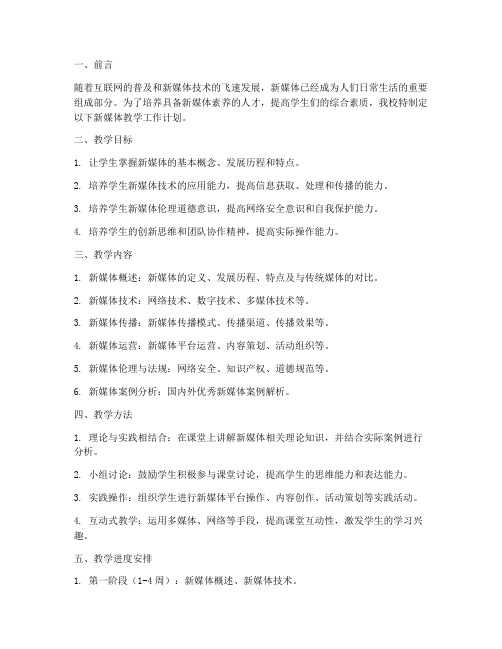
一、前言随着互联网的普及和新媒体技术的飞速发展,新媒体已经成为人们日常生活的重要组成部分。
为了培养具备新媒体素养的人才,提高学生们的综合素质,我校特制定以下新媒体教学工作计划。
二、教学目标1. 让学生掌握新媒体的基本概念、发展历程和特点。
2. 培养学生新媒体技术的应用能力,提高信息获取、处理和传播的能力。
3. 培养学生新媒体伦理道德意识,提高网络安全意识和自我保护能力。
4. 培养学生的创新思维和团队协作精神,提高实际操作能力。
三、教学内容1. 新媒体概述:新媒体的定义、发展历程、特点及与传统媒体的对比。
2. 新媒体技术:网络技术、数字技术、多媒体技术等。
3. 新媒体传播:新媒体传播模式、传播渠道、传播效果等。
4. 新媒体运营:新媒体平台运营、内容策划、活动组织等。
5. 新媒体伦理与法规:网络安全、知识产权、道德规范等。
6. 新媒体案例分析:国内外优秀新媒体案例解析。
四、教学方法1. 理论与实践相结合:在课堂上讲解新媒体相关理论知识,并结合实际案例进行分析。
2. 小组讨论:鼓励学生积极参与课堂讨论,提高学生的思维能力和表达能力。
3. 实践操作:组织学生进行新媒体平台操作、内容创作、活动策划等实践活动。
4. 互动式教学:运用多媒体、网络等手段,提高课堂互动性,激发学生的学习兴趣。
五、教学进度安排1. 第一阶段(1-4周):新媒体概述、新媒体技术。
2. 第二阶段(5-8周):新媒体传播、新媒体运营。
3. 第三阶段(9-12周):新媒体伦理与法规、新媒体案例分析。
4. 第四阶段(13-16周):实践操作、课程总结。
六、考核方式1. 平时成绩:课堂表现、作业完成情况、小组讨论等。
2. 期末考试:理论知识和实践操作相结合的笔试。
3. 案例分析报告:学生结合所学知识,对某一新媒体案例进行分析。
七、教学资源1. 教材:《新媒体概论》、《新媒体传播学》、《新媒体运营与管理》等。
2. 网络资源:国内外优秀新媒体平台、案例分析、行业报告等。
大学生新媒体学期工作计划

一、前言随着互联网技术的飞速发展,新媒体已经成为当今社会传播信息的重要渠道。
作为新时代的大学生,我们应当充分利用新媒体平台,传播正能量,弘扬社会主义核心价值观。
本学期,我部将围绕以下目标开展各项工作。
二、工作目标1. 提升校园媒体影响力,扩大宣传覆盖面,打造具有影响力的校园新媒体品牌。
2. 培养一批具有新媒体素养的校园媒体人才,为学校宣传工作提供有力支持。
3. 加强与其他部门、院系的合作,共同推进校园文化建设。
4. 完善新媒体运营体系,提高新媒体内容质量,提升用户体验。
三、具体工作计划1. 内容策划与制作(1)围绕学校重大活动、节日、纪念日等,策划系列专题报道,如“校园之星”、“青春榜样”等。
(2)关注校园热点话题,开展深度报道,传递正能量。
(3)定期发布原创文章,提高内容质量,丰富读者视野。
2. 平台运营与推广(1)加强各大新媒体平台的日常运营,保持活跃度。
(2)开展线上线下活动,提高粉丝互动,增强粉丝粘性。
(3)与其他新媒体平台合作,扩大宣传覆盖面。
3. 团队建设与培训(1)定期组织团队成员参加新媒体技能培训,提高团队整体水平。
(2)开展团队交流活动,促进成员间的相互学习与成长。
(3)选拔优秀人才,充实团队力量。
4. 跨部门合作(1)与学校相关部门、院系开展合作,共同策划、组织活动。
(2)邀请专家、学者进行讲座,提升团队综合素质。
(3)与其他高校新媒体团队交流学习,共同进步。
5. 质量监控与评估(1)建立健全内容审核机制,确保发布内容健康、积极。
(2)定期对新媒体运营数据进行统计分析,评估工作效果。
(3)根据评估结果,调整工作策略,持续优化新媒体运营。
四、总结本学期,大学生新媒体中心将紧紧围绕工作目标,积极开展各项工作。
通过加强团队建设、提高内容质量、拓展宣传渠道等手段,努力打造具有影响力的校园新媒体品牌。
我们坚信,在全体成员的共同努力下,大学生新媒体中心一定能够为学校宣传工作做出更大贡献。
新媒体与传媒教学计划
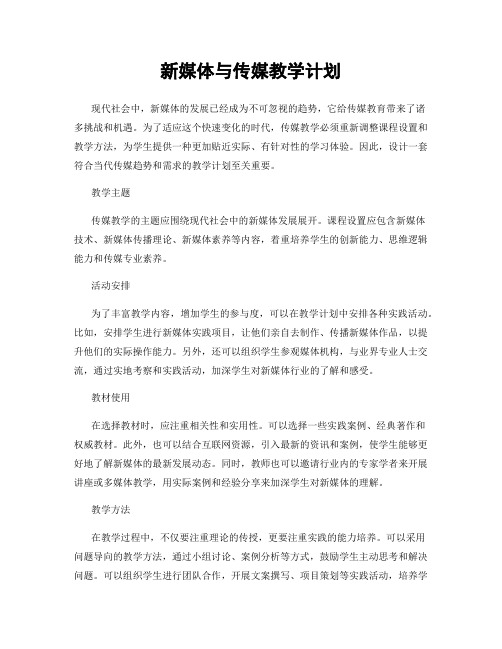
新媒体与传媒教学计划现代社会中,新媒体的发展已经成为不可忽视的趋势,它给传媒教育带来了诸多挑战和机遇。
为了适应这个快速变化的时代,传媒教学必须重新调整课程设置和教学方法,为学生提供一种更加贴近实际、有针对性的学习体验。
因此,设计一套符合当代传媒趋势和需求的教学计划至关重要。
教学主题传媒教学的主题应围绕现代社会中的新媒体发展展开。
课程设置应包含新媒体技术、新媒体传播理论、新媒体素养等内容,着重培养学生的创新能力、思维逻辑能力和传媒专业素养。
活动安排为了丰富教学内容,增加学生的参与度,可以在教学计划中安排各种实践活动。
比如,安排学生进行新媒体实践项目,让他们亲自去制作、传播新媒体作品,以提升他们的实际操作能力。
另外,还可以组织学生参观媒体机构,与业界专业人士交流,通过实地考察和实践活动,加深学生对新媒体行业的了解和感受。
教材使用在选择教材时,应注重相关性和实用性。
可以选择一些实践案例、经典著作和权威教材。
此外,也可以结合互联网资源,引入最新的资讯和案例,使学生能够更好地了解新媒体的最新发展动态。
同时,教师也可以邀请行业内的专家学者来开展讲座或多媒体教学,用实际案例和经验分享来加深学生对新媒体的理解。
教学方法在教学过程中,不仅要注重理论的传授,更要注重实践的能力培养。
可以采用问题导向的教学方法,通过小组讨论、案例分析等方式,鼓励学生主动思考和解决问题。
可以组织学生进行团队合作,开展文案撰写、项目策划等实践活动,培养学生的团队合作和协调能力。
同时,可以利用多媒体技术和网络教育平台,提供自主学习和反馈机制,鼓励学生积极参与课程学习和互动讨论。
评估方式评估方式应与教学目标相一致。
可以通过课堂问答、作业、论文等方式对学生的掌握程度进行评估。
同时,也可以设置项目作业和实践考核,通过实际操作来评估学生的实践能力。
在评估过程中,还可以结合学生的自我评价和同行评价,培养学生的自我认知和交流能力。
总结新媒体与传媒教学计划的设计和实施,是对传统教学模式的一次创新尝试。
大学新媒体学期工作计划

一、前言随着信息技术的飞速发展,新媒体已经成为当代大学生获取信息、交流思想的重要平台。
为了更好地发挥新媒体在校园文化建设和学生思想政治教育中的作用,结合我国高等教育事业发展的要求,特制定本学期新媒体工作计划。
二、工作目标1. 提升新媒体平台的传播力,扩大校园文化影响力;2. 加强新媒体团队建设,提高团队整体素质;3. 增强新媒体与校园各部门、各学院之间的沟通与合作;4. 深化新媒体在学生思想政治教育中的功能,引导学生树立正确的价值观。
三、具体措施1. 优化新媒体平台(1)完善平台功能,提升用户体验;(2)丰富内容,增加原创性、趣味性、实用性;(3)加强与其他新媒体平台的合作,实现资源共享。
2. 加强新媒体团队建设(1)定期组织培训,提高团队成员的专业技能;(2)选拔优秀人才,优化团队结构;(3)加强团队凝聚力,营造良好的工作氛围。
3. 深化新媒体与校园各部门、各学院之间的合作(1)加强与校团委、学生会的沟通,共同策划校园文化活动;(2)与各学院建立联系,了解学生需求,提供有针对性的服务;(3)与其他高校新媒体团队交流,学习先进经验。
4. 深化新媒体在学生思想政治教育中的功能(1)结合时事热点,开展主题教育活动;(2)传播社会主义核心价值观,引导学生树立正确的价值观;(3)关注学生心理健康,提供心理咨询和帮助。
四、工作安排1. 第一阶段(第1-4周):进行新媒体平台优化、团队建设,制定详细工作计划。
2. 第二阶段(第5-8周):开展校园文化活动,提升新媒体平台传播力。
3. 第三阶段(第9-12周):深化新媒体在学生思想政治教育中的功能,关注学生心理健康。
4. 第四阶段(第13-16周):总结本学期工作,对新媒体团队进行评估,制定下学期工作计划。
五、保障措施1. 加强组织领导,明确责任分工;2. 加大经费投入,确保工作顺利开展;3. 加强监督检查,确保工作落到实处。
通过本学期新媒体工作计划的实施,我们将不断提升新媒体在校园文化建设和学生思想政治教育中的作用,为我国高等教育事业的发展贡献力量。
媒体与传播学课程教学计划
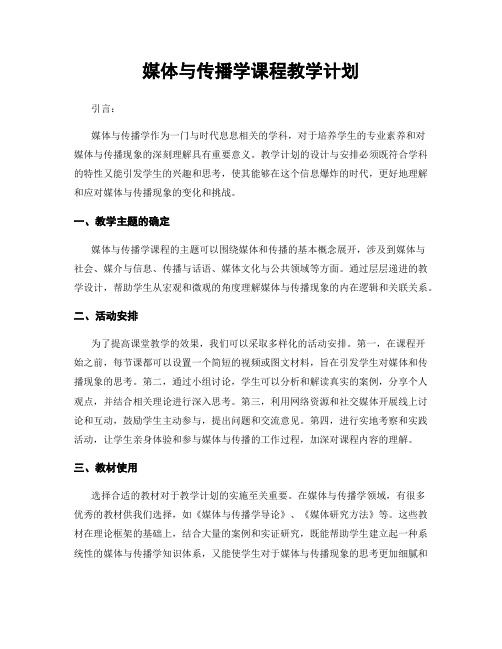
媒体与传播学课程教学计划引言:媒体与传播学作为一门与时代息息相关的学科,对于培养学生的专业素养和对媒体与传播现象的深刻理解具有重要意义。
教学计划的设计与安排必须既符合学科的特性又能引发学生的兴趣和思考,使其能够在这个信息爆炸的时代,更好地理解和应对媒体与传播现象的变化和挑战。
一、教学主题的确定媒体与传播学课程的主题可以围绕媒体和传播的基本概念展开,涉及到媒体与社会、媒介与信息、传播与话语、媒体文化与公共领域等方面。
通过层层递进的教学设计,帮助学生从宏观和微观的角度理解媒体与传播现象的内在逻辑和关联关系。
二、活动安排为了提高课堂教学的效果,我们可以采取多样化的活动安排。
第一,在课程开始之前,每节课都可以设置一个简短的视频或图文材料,旨在引发学生对媒体和传播现象的思考。
第二,通过小组讨论,学生可以分析和解读真实的案例,分享个人观点,并结合相关理论进行深入思考。
第三,利用网络资源和社交媒体开展线上讨论和互动,鼓励学生主动参与,提出问题和交流意见。
第四,进行实地考察和实践活动,让学生亲身体验和参与媒体与传播的工作过程,加深对课程内容的理解。
三、教材使用选择合适的教材对于教学计划的实施至关重要。
在媒体与传播学领域,有很多优秀的教材供我们选择,如《媒体与传播学导论》、《媒体研究方法》等。
这些教材在理论框架的基础上,结合大量的案例和实证研究,既能帮助学生建立起一种系统性的媒体与传播学知识体系,又能使学生对于媒体与传播现象的思考更加细腻和深入。
此外,还可以结合学术论文、新闻报道、音视频资源等多种媒体材料,拓宽学生的视野和学术素养。
结语:通过合理的教学计划的设计和安排,在媒体与传播学课程中不仅能够提高学生的学术能力,还能够培养学生的创新思维和批判精神。
随着新媒体和传播技术的不断发展,媒体与传播学课程的教学计划也需要与时俱进,保持与实际应用的紧密联系,使学生能够更好地把握媒体与传播的发展动态,并为未来的研究和实践打下坚实的基础。
新媒体新闻教学设计方案

1. 知识目标:使学生了解新媒体新闻的基本概念、特点和发展趋势,掌握新媒体新闻的采编、制作和传播方法。
2. 能力目标:培养学生新媒体新闻的采编能力、写作能力、制作能力和传播能力。
3. 情感目标:激发学生对新媒体新闻事业的热爱,提高学生的社会责任感和使命感。
二、教学内容1. 新媒体新闻概述:新媒体新闻的定义、特点、发展趋势及与传统新闻的区别。
2. 新媒体新闻采编:采访技巧、写作技巧、摄影技巧、视频制作技巧。
3. 新媒体新闻制作:新闻编辑、排版、图文设计、视频剪辑。
4. 新媒体新闻传播:社交媒体运营、网络营销、新闻发布平台选择。
三、教学方法1. 讲授法:系统讲解新媒体新闻的基本概念、特点和发展趋势。
2. 案例分析法:通过分析典型案例,使学生了解新媒体新闻的采编、制作和传播方法。
3. 实践操作法:引导学生进行新闻采访、写作、制作和传播的实践操作。
4. 小组讨论法:组织学生分组讨论,提高学生的团队协作能力和沟通能力。
四、教学过程1. 导入新课:通过播放新媒体新闻的相关视频,激发学生的学习兴趣。
2. 讲解知识点:系统讲解新媒体新闻的基本概念、特点和发展趋势。
3. 案例分析:选取典型案例,分析新媒体新闻的采编、制作和传播方法。
4. 实践操作:组织学生进行新闻采访、写作、制作和传播的实践操作。
5. 小组讨论:分组讨论新媒体新闻的发展趋势、行业前景等问题。
6. 总结评价:对学生的学习成果进行总结评价,提出改进意见。
1. 课堂表现:观察学生在课堂上的参与程度、互动情况等。
2. 实践操作:评估学生在新闻采访、写作、制作和传播方面的实际操作能力。
3. 作品评价:对学生的新闻作品进行评价,包括内容、形式、创新等方面。
4. 反馈意见:收集学生对教学内容的意见和建议,不断优化教学方案。
六、教学资源1. 教材:选用权威的新媒体新闻教材,为学生提供系统的知识体系。
2. 案例库:收集国内外新媒体新闻的典型案例,供学生分析和学习。
新媒体学习计划(3篇)

新媒体学习计划(3篇)新媒体学习计划(精选3篇)新媒体学习计划篇1新媒体部是学生会中负责新闻文化传播的技术部门,主要工作有新闻报道和舆论监督以及以媒体为媒介进行的文化传播。
新学期伊始,管理系学生会的各项工作已经有条不紊地展开。
为了更好地促进新媒体部的发展,加强与学生会其他部门的沟通交流,服务全系师生。
结合第一一年的总体工作情况和经验教训,特制定新学年部门工作计划,已备工作之需。
内容如下:一、工作概要新学期新媒体部的工作重点是提升成员的通讯稿写作能力和新媒体平台的管理能力。
同时,落实各项工作制度,让工作有章可循。
二、总体构想1、调整部门新学期的工作重点。
把培养成员的宣传能力转化为培养成员的写作报道能力上,进而提高新媒体部门通讯报道的质量;2、加强新媒体部的宣传配合作用加强各部门的联系,积极主动的行使宣传职能,为我系学生会的宣传工作再添亮点;3、充分利用QQ、微信、微博、贴吧等新媒体,做好学院活动的宣传工作;4、改革新媒体内部的运行机制。
让部门每个人的能力都得以发挥,得以提高,拥有锻炼的空间;5、进一步完善部门内部的规章制度,提高工作成员的工作积极性,提高工作质量;6、加强部门自身建设和部门间的交流。
鼓励部门成员与其他部门成员交往,及时了解其他部门信息,把工作状态由原来的被动转为主动,协助其他部门工作的完成,以更好的起到宣传作用。
三、宣传工作方面(新媒体)1、新浪微博的运行管理新浪微博由上学期的I11人涨到131人,增幅15.2%;收听26个省、校、学院组织官方微博,做到了让学生每天有东西可读,其中转发省、校团组织信息69次,有效扩大了省校团组织在学生中的影响。
但是收听人数仅占全系人数的比率不足三分之一,对此新媒体部根据以往存在的不足与问题,计划建立私信后台自动回复功能,更加系统地完善微博产品。
并且计划在本学期把微博关注人数的比率提到二分之一以上(资料截至到15年3月22日)2、微信公众平台的创新(1)整体目标当下微信平台凭借其强大的信息推送功能,简介明了的页面正在飞速发展且有逆袭微博、贴吧之势。
媒体教学工作计划

媒体教学工作计划一、工作目标通过学校媒体教学工作,使学生掌握基本的媒体素养和技能,具备批判性思维和创造力,为未来的职业生涯做好准备。
二、工作内容1. 制定媒体教学课程设立基本的媒体教学课程,包括媒体基础知识、媒体生产技能、媒体分析和批判性思维等方面的内容,确保学生在媒体领域有扎实的基础知识和技能。
2. 教学资源建设建设媒体教学资源,包括教室设备、媒体制作工具、实习实训基地等,以支持学生的学习和实践活动。
同时,加强媒体教学团队的建设,培养教师的媒体教学技能和专业素养。
3. 媒体教学活动开展组织和开展一系列的媒体教学活动,如媒体作品展示、媒体论坛、媒体实践等,鼓励学生积极参与,培养学生的媒体创作和批判性思维能力。
4. 媒体教学评估建立媒体教学评估机制,对学生的学习成果进行评价,确定和鼓励优秀学生,对学生的成长和发展提供有效的指导。
5. 媒体教学研究开展媒体教学相关的研究,促进媒体教学的创新和发展,提高教学质量和水平,为学校改进教学和培养高素质媒体人才提供有力的支持。
三、工作计划1. 制定媒体教学课程首先,我们将组建由媒体相关专业的教师和行业专家组成的课程编写团队,制定符合学校特色和学生需求的媒体教学课程大纲,并根据实际情况调整和完善课程内容。
2. 教学资源建设学校将加大对媒体教学资源的投入,更新和升级教室设备、购置最新的媒体制作工具和软件,建设媒体实训基地,并鼓励学生利用这些资源开展媒体项目和实践活动。
3. 媒体教学活动开展在学期间,学校将定期组织媒体作品展示、媒体论坛和媒体实践等活动,鼓励学生展示自己的媒体作品,分享和交流媒体创意和经验,提高他们在媒体领域的能力和竞争力。
4. 媒体教学评估学校将建立多元化的媒体教学评估体系,包括课堂考核、实践成果展示、实习评估等,对学生的学习成果进行综合评价,确保学生在媒体教学过程中取得实实在在的进步和提高。
5. 媒体教学研究学校将支持媒体教学相关的科研项目和学术研究,鼓励教师和学生积极参与,并组织媒体教学研讨会和学术论坛,促进学术交流和思想碰撞,共同促进媒体教学的不断创新和发展。
新学期新媒体工作计划

一、前言随着新媒体的迅速发展,新媒体已经成为信息传播的重要渠道。
为了更好地发挥新媒体的作用,提高我校的宣传效果,特制定本学期新媒体工作计划。
二、工作目标1. 提高我校新媒体的传播力、影响力,扩大我校的知名度。
2. 加强与校内各部门的沟通与合作,形成宣传合力。
3. 丰富新媒体内容,满足师生需求,提高用户体验。
4. 培养一支高素质的新媒体运营团队。
三、具体工作内容1. 完善新媒体平台建设(1)优化现有新媒体平台,提高用户体验。
(2)拓展新媒体平台,增加传播渠道。
2. 内容策划与制作(1)围绕学校重点工作,策划专题活动,推出系列报道。
(2)挖掘校园热点,制作原创内容,提高内容质量。
(3)加强与其他媒体平台的合作,共享优质资源。
3. 活动宣传与推广(1)利用新媒体平台,及时发布活动信息,扩大活动影响力。
(2)开展线上线下宣传活动,提高活动参与度。
(3)组织新媒体团队参与活动报道,展现活动盛况。
4. 培训与交流(1)定期举办新媒体培训,提高团队成员的业务水平。
(2)加强与校内各部门的交流,分享新媒体运营经验。
(3)组织外出学习,拓宽团队视野。
5. 营销与推广(1)开展新媒体广告业务,拓宽收入来源。
(2)与商家合作,举办线上线下活动,提高品牌知名度。
(3)开展新媒体营销课程,培养专业人才。
四、工作措施1. 加强组织领导,成立新媒体工作小组,明确责任分工。
2. 制定详细的工作计划,明确时间节点和任务要求。
3. 加强团队建设,提高团队成员的凝聚力和执行力。
4. 注重数据分析,及时调整工作策略。
5. 加强与校内各部门的沟通与合作,形成宣传合力。
五、预期效果通过本学期新媒体工作计划的实施,预计达到以下效果:1. 新媒体传播力、影响力显著提升。
2. 校园活动宣传效果明显,参与度提高。
3. 新媒体团队业务水平得到提升,团队凝聚力增强。
4. 新媒体收入来源拓宽,为学校创造经济效益。
总之,本学期新媒体工作计划旨在充分发挥新媒体的传播优势,提高我校的宣传效果,为学校发展贡献力量。
新媒体学习计划方案

新媒体学习计划方案一、引言随着科技的不断进步,新媒体行业也日益繁荣。
从社交媒体到数字营销,无论是个人还是企业,在新媒体的时代都需要掌握相关的知识和技能。
因此,设计一份全面而系统的新媒体学习计划对于提升个人或企业在新媒体领域的竞争力至关重要。
本方案将详细介绍新媒体学习计划的内容和步骤,帮助学员逐步提升自己在新媒体领域的能力和素质。
二、学习目标1. 了解新媒体的发展历程和特点,把握新媒体行业的概况;2. 熟悉新媒体的基本知识和工具,掌握新媒体内容的产出和传播;3. 掌握新媒体营销策略和方法,提升品牌在新媒体上的影响力;4. 学会新媒体数据分析和监测,提高数据驱动的决策能力。
三、学习内容1. 新媒体基础知识- 新媒体的概念和发展历程- 新媒体的特点和分类- 新媒体的技术和工具2. 新媒体内容创作及传播- 内容创意的基本原则和方法- 内容生产的流程和工具- 内容传播的渠道和策略3. 新媒体营销策略- 新媒体营销的趋势和特点- 新媒体营销策略的制定和执行- 新媒体营销效果评估和优化4. 新媒体数据分析和监测- 新媒体数据的分类和获取- 数据分析的基本方法和工具- 数据监测的流程和指标四、学习计划1. 学习时间安排- 每周安排固定的学习时间,保证学习的连续性和规律性;- 设置学习目标和任务,根据学习内容制定学习进度表。
2. 学习材料准备- 收集相关的新媒体学习资料,包括书籍、网络课程、案例和工具; - 注重实践,找到合适的实战项目进行参与和实践。
3. 学习方法- 注重理论和实践的结合,理论知识与实际操作相结合;- 多方面的学习途径,包括阅读、听课、实践等。
4. 学习评估- 定期对自己的学习成果进行评估,总结经验和教训;- 寻求他人的反馈和帮助,积极参与学习小组和讨论。
五、学习资源1. 新媒体学习书籍- 《新媒体营销》- 《数字化时代的内容营销》- 《社交媒体营销策略》2. 新媒体网络课程- 网易云课堂- 慕课网- Coursera3. 新媒体实践工具- 微信公众平台- 微博营销平台- Facebook广告管理工具六、学习心得新媒体学习是一个系统性、长期性的过程,需要不断的学习和实践。
清华新传考研内部资料

清华新传考研内部资料一、清华大学新闻传播专业考研信息解读清华新闻与传播考研——院校简介清华大学新闻与传播学院的前身,是1985年在中文系设立的编辑学方向和1998年10月成立的传播系。
多年来,从中文系的编辑学专业到传播系,直到成立新闻与传播学院,凭借日益增强的新闻学和传播学的学科基础,围绕着国际传播、影视传播、新媒体传播、媒介经营与管理等主要方向,清华大学逐渐形成了精干的新闻与传播教学科研师资团队,增强了在学界、业界的影响力,尤其在国际传播、媒体与科技、艺术相结合和影视理论与批评等方面的学术研究中取得一定的优势。
学院领导及师资力量柳斌杰任清华新闻学院院长。
教授中有方汉奇先生得意弟子、中国新闻传播史学会副会长、前北大新闻传播系主任陈昌凤博士。
尹鸿,李彬。
二、清华大学新闻与传播专业考研专业课复习参考书618新闻与传播史论一、名词解释1.精确新闻学2.棱镜门事件3.拟态环境4.二级传播理论5.尼尔波兹曼6.观点的自由市场7.蒙太奇8.美国便士报运动9.史量才二、简答1.当前中国媒介融合的内涵与意义2.梁启超的新闻思想3.移动互联网时代人类社会信息传播环境的变化三、论述1.分析微博等社交媒体对中国社会发展与转型的影响2.经典传播理论在当下互联网时代还适用吗?举两个例子3.关于大v责任运动,说说你的看法862新闻与传播业务一、简答题1.简述推动媒介形态变化发展的主要动力2.简述量化研究方法和质化研究方法的差异3.移动互联网时代人类社会信息传播环境的变化二、业务题1.中央媒体通过微博微信等表现活跃,拥有众多粉丝,这对中国传媒的格局意味着什么?2.从近年热播电视节目中任选其一分析TV9的品牌传播特点三、论述题1.材料(大意是说南方报业集团赔了,还赔了不少)这种状况是怎么出现的?是全行业还是几家媒体的困境?经营上的低估对于新闻生产会带来什么影响?2.选择2013年在传统媒体和网络媒体上出现的失范事件各一例,从伦理与规制的角度进行评述。
学校新媒体新学期工作计划
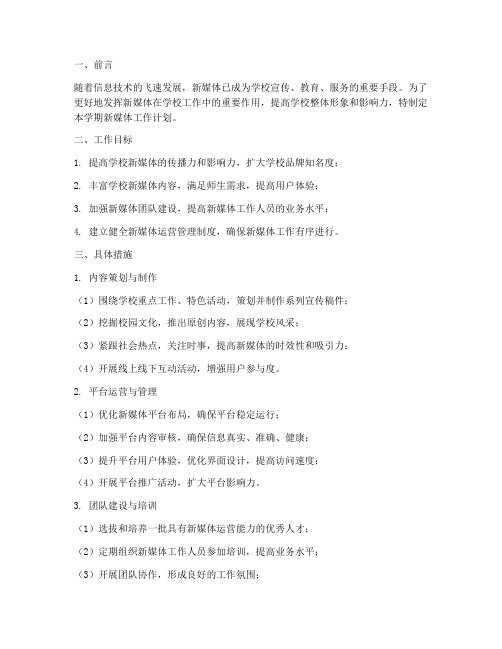
一、前言随着信息技术的飞速发展,新媒体已成为学校宣传、教育、服务的重要手段。
为了更好地发挥新媒体在学校工作中的重要作用,提高学校整体形象和影响力,特制定本学期新媒体工作计划。
二、工作目标1. 提高学校新媒体的传播力和影响力,扩大学校品牌知名度;2. 丰富学校新媒体内容,满足师生需求,提高用户体验;3. 加强新媒体团队建设,提高新媒体工作人员的业务水平;4. 建立健全新媒体运营管理制度,确保新媒体工作有序进行。
三、具体措施1. 内容策划与制作(1)围绕学校重点工作、特色活动,策划并制作系列宣传稿件;(2)挖掘校园文化,推出原创内容,展现学校风采;(3)紧跟社会热点,关注时事,提高新媒体的时效性和吸引力;(4)开展线上线下互动活动,增强用户参与度。
2. 平台运营与管理(1)优化新媒体平台布局,确保平台稳定运行;(2)加强平台内容审核,确保信息真实、准确、健康;(3)提升平台用户体验,优化界面设计,提高访问速度;(4)开展平台推广活动,扩大平台影响力。
3. 团队建设与培训(1)选拔和培养一批具有新媒体运营能力的优秀人才;(2)定期组织新媒体工作人员参加培训,提高业务水平;(3)开展团队协作,形成良好的工作氛围;(4)鼓励新媒体工作人员创新,提高工作质量。
4. 协作与交流(1)加强与校内各部门的沟通与协作,确保新媒体工作与学校整体工作相协调;(2)与其他高校新媒体团队开展交流,学习先进经验,提升自身水平;(3)与媒体、企业等外部机构建立合作关系,拓宽新媒体发展空间;(4)关注国内外新媒体发展趋势,把握行业动态。
四、时间安排1. 第一阶段(第1-4周):制定新媒体工作计划,开展团队培训,明确工作目标;2. 第二阶段(第5-8周):策划并制作系列宣传稿件,优化平台布局,开展线上线下活动;3. 第三阶段(第9-12周):加强内容审核,提升用户体验,开展团队协作,提高工作效率;4. 第四阶段(第13-16周):总结经验,优化新媒体工作流程,提升新媒体整体水平。
高校新媒体工作计划模板

一、前言随着信息技术的飞速发展,新媒体已成为高校传播信息、开展活动、服务师生的重要平台。
为更好地发挥新媒体在高校工作中的积极作用,特制定以下工作计划。
二、工作目标1. 提升新媒体平台的传播力、引导力、影响力和公信力,增强校园文化的凝聚力和影响力。
2. 建立健全新媒体运营机制,提高工作效率和质量。
3. 深化新媒体与校园其他部门的合作,实现资源共享,共同推动校园文化建设。
三、工作内容1. 平台建设与维护(1)优化新媒体平台界面设计,提升用户体验;(2)定期更新平台内容,保持内容丰富、新鲜;(3)加强平台互动,提高用户参与度;(4)定期对平台进行维护,确保稳定运行。
2. 内容策划与制作(1)围绕学校中心工作,策划、制作具有教育意义、文化内涵、生活趣味的原创内容;(2)关注校园热点事件,及时发布权威信息,引导舆论;(3)挖掘校园文化内涵,展示校园风采,提升校园形象;(4)加强与其他媒体的合作,引入优质内容。
3. 宣传推广(1)利用新媒体平台,宣传学校政策、通知、活动等信息;(2)开展线上线下活动,扩大新媒体平台的影响力;(3)与校内媒体、校外媒体合作,共同开展宣传推广活动;(4)定期分析平台数据,优化宣传策略。
4. 营销与推广(1)策划、开展线上线下营销活动,提高新媒体平台知名度;(2)开展用户调研,了解用户需求,为营销活动提供依据;(3)加强与其他部门的合作,实现资源共享,共同开展营销活动。
5. 团队建设与培训(1)加强新媒体团队建设,提高团队凝聚力和执行力;(2)定期开展团队培训,提升团队成员的技能水平;(3)鼓励团队成员参与新媒体行业交流,学习先进经验。
四、工作措施1. 加强组织领导,成立新媒体工作小组,明确各部门职责;2. 建立健全新媒体管理制度,确保工作有序开展;3. 定期召开新媒体工作例会,总结经验,分析问题,调整工作策略;4. 加强与其他部门的沟通与协作,实现资源共享,共同推动校园文化建设;5. 鼓励团队成员积极参与新媒体工作,发挥个人特长,共同为校园文化建设贡献力量。
新媒体课程学习计划

新媒体课程学习计划一、课程介绍新媒体是指运用信息通信技术,以数字化形式传播内容的媒体形态。
新媒体课程是针对新媒体时代的需求,研究新媒体传播、新媒体营销、新媒体设计等相关知识和技能。
本课程将从新媒体的发展趋势、应用技术、传播方式等方面展开学习,旨在培养学生在新媒体领域的专业知识和技能。
二、学习目标1. 理解和掌握新媒体的概念和特点。
2. 掌握新媒体的各种应用技术和工具。
3. 熟悉新媒体的传播方式和营销策略。
4. 学习新媒体设计的相关知识和技能。
5. 能够独立进行新媒体项目的策划和实施。
三、学习内容1. 新媒体概念新媒体的定义、特点、发展趋势等。
2. 新媒体技术包括网络技术、移动技术、云计算技术、大数据技术等。
3. 新媒体传播新媒体的传播方式、传播原理、传播机制等。
4. 新媒体营销网络营销、社交媒体营销、内容营销等。
5. 新媒体设计包括网站设计、APP设计、平面设计等。
6. 新媒体案例分析分析和研究当下流行的新媒体案例。
四、学习方式1. 线上学习:通过网络课程、视频教学等方式进行学习。
2. 线下学习:结合实践案例、参观考察、实训等形式进行学习。
3. 自主学习:学生可根据自身情况进行自主学习和实践。
五、学习方法1. 系统学习:按照课程安排,有计划地进行学习,掌握基本理论和知识。
2. 实践应用:结合案例分析和项目实施,掌握实际操作技能。
3. 综合训练:通过综合实训和练习,提升综合素质和能力。
六、学习安排1. 第一周:新媒体概念和特点的学习。
2. 第二周:新媒体技术的学习。
3. 第三周:新媒体传播的学习。
4. 第四周:新媒体营销的学习。
5. 第五周:新媒体设计的学习。
6. 第六周:新媒体案例分析。
七、学习资源1. 教材:选用权威的新媒体教材进行学习。
2. 网络资源:利用网络资源进行学习,如网络课程、学术论坛、学术期刊等。
3. 实践机会:参与实践项目、实训课程,拓展实践经验。
八、学习评估1. 平时成绩:包括课堂表现、作业完成情况等。
新媒体学堂工作计划

新媒体学堂工作计划
新媒体学堂工作计划应包括以下几个关键方面:
1. 目标设定:
- 明确新媒体学堂的愿景和使命。
- 确定短期和长期的目标,例如提升学员的新媒体运用能力,增加
学员数量等。
2. 市场调研:
- 调研目标受众的需求和偏好。
- 分析竞争对手的优势和不足。
3. 课程开发:
- 根据调研结果设计课程大纲。
- 开发多样化的课程内容,包括基础理论、实践操作、案例分析等。
4. 师资队伍建设:
- 招募具有新媒体领域专业知识和实践经验的讲师。
- 定期对讲师进行培训和评估,确保教学质量。
5. 技术平台搭建:
- 选择合适的在线教育平台或开发定制平台。
- 确保平台的稳定性和易用性,提供良好的学习体验。
6. 营销推广:
- 制定营销策略,包括社交媒体宣传、合作伙伴关系建立等。
- 利用数据分析工具监控营销效果,及时调整策略。
7. 学员服务与支持:
- 提供个性化的学习计划和辅导。
- 建立学员社区,促进学员之间的交流和互动。
8. 质量监控与评估:
- 定期对课程内容和教学效果进行评估。
- 根据学员反馈进行课程优化。
9. 风险管理:
- 识别可能的风险因素,如技术故障、市场竞争等。
- 制定应对策略,减少风险对学堂运营的影响。
10. 持续改进:
- 建立持续改进机制,鼓励创新思维。
- 定期回顾工作计划,根据市场变化和学员需求进行调整。
通过上述工作计划的实施,新媒体学堂可以有效地提升教育质量,满足市场需求,实现可持续发展。
新媒体学习计划书

新媒体学习计划书一、学习目标在当今信息化时代,新媒体已经成为社会发展的重要驱动力。
为了适应这一发展趋势,我决定深入学习新媒体相关知识,提升自己的综合素质和竞争力。
具体学习目标如下:1. 掌握新媒体的基本理论和概念,了解新媒体的发展历程和未来趋势;2. 学习并掌握新媒体的操作技能,包括社交媒体管理、数字营销、内容创作等;3. 深入理解数字化传播的特点和规律,提高自己的传播能力和创新能力;4. 提升自己的跨学科素养,了解新媒体与其他学科领域的交叉融合,掌握相关知识和技能。
二、学习内容1. 新媒体基础知识1.1 新媒体概念和特点1.2 新媒体发展历程1.3 新媒体传播理论1.4 新媒体技术发展趋势2. 社交媒体运营2.1 社交媒体常用平台及功能介绍2.2 社交媒体运营策略2.3 粉丝运营和互动管理2.4 数据分析和监测3. 数字营销3.1 数字营销基本概念3.2 内容营销策略3.3 移动营销和电商营销3.4 数据驱动的营销手段4. 内容创作4.1 创意写作和文案策划4.2 视频、图像和音频创作4.3 多媒体内容编辑和发布4.4 内容营销与传播5. 新媒体传播案例分析5.1 分析国内外知名新媒体案例5.2 探索成功案例的传播机制和策略5.3 借鉴案例经验,提升自己的实践能力6. 跨学科素养拓展6.1 新媒体与人文学科的交叉研究6.2 新媒体与科技、经济、社会学的关系6.3 探索新媒体与其他领域的合作模式和发展路径三、学习方法1. 自主学习通过阅读相关书籍、论文和资料,了解新媒体的基本知识和最新动态,建立扎实的理论基础。
2. 实践操作注重实操能力的培养,积极参与社交媒体运营、内容创作等实践活动,了解数字营销和社交媒体运营的操作流程和技巧。
3. 案例分析学习分析国内外成功的新媒体传播案例,总结其成功经验和传播策略,加强自己的传播思维和分析能力。
4. 资源整合利用互联网和各类学术资源,获取最新的新媒体资讯和实用技能教程,提高自己的学习效率和水平。
- 1、下载文档前请自行甄别文档内容的完整性,平台不提供额外的编辑、内容补充、找答案等附加服务。
- 2、"仅部分预览"的文档,不可在线预览部分如存在完整性等问题,可反馈申请退款(可完整预览的文档不适用该条件!)。
- 3、如文档侵犯您的权益,请联系客服反馈,我们会尽快为您处理(人工客服工作时间:9:00-18:30)。
New Media Studies <研究生课程班 Spring 2011>
Instructor: Jia Lu Email: lujiantu@ Tel: 6279-5415 Class Hours: Saturday 9:00 AM to 12:00 AM Class Dates: Feb. 26; Mar. 5, 12, 19, 26; Apr. 9, 16; May 7, 14, 21 Classroom: 四教 106 Office Hours: Tuesday 3:30 PM — 5:30 PM or any other time by appointment My Office: Omnicom Building 3093
Description The increasing rate of technological change in the communications industry has serious implications, both for professionals in communications related fields, and for members of society who use electronically mediated communications in their everyday life. This course is designed to introduce students of communication to these changing communication technologies and link technological changes to trends in mass media industries, as well as shifts in cultural norms and practices. The objectives of this course are:
Survey the history, growth and structure of technological systems underpinning the contemporary media landscape of the information society, Identify key theoretical approaches to describing the relationships between communication, culture, social organization, and information and communication technologies (ICTs), Identify trends contributing to the process of technological convergence among media systems, and Highlight contemporary social problems that can be understood and evaluated critically by using concepts and research from media studies.
Textbooks: Available in the library of Tsinghua University
1. 今日媒介: 理解媒介、文化与技术(第四版)(影印)(英文版) 清华大学出版社
2. 3.
Castells, M. (2000) The Rise of the Network Society (2nd ed.). Malden, MA: Blackwell. Lievrouw, L. A., & Livingstone, S. (2006). Handbook of new media: Social shaping and social consequences of ICTs. London: Sage.
Grades Attendance & Participation: Attendance and participation reflect students’ commitment to this course. Please feel free to raise your questions and comments in the classroom. I really appreciate it. Group Presentation: 1. 6 or 7 students are in one group to choose a topic about new media studies under the guidance of our teaching assistants. There will be 16 groups in total.
2. 3.
4.
Each presentation lasts for about 20-25 minutes. The presentation includes two major parts: First, the presentation will introduce some cutting-edge ICTs and their applications in particular fields. Second, the presentation will provide some theoretical or thoughtful ideas for the class to have a better understanding about what covered in the first part. The topics of the presentation can cover but not limit to: new media & politics, new media & education, new media & health, new media & gender, new media & security, new media & social engagement, new media & entertainment, new media & privacy, new media & piracy, new media & religion, new media & culture, or new media & globalization.
Final Paper: By the end of the semester, each student is asked to submit a final paper. The requirements of the final paper will be discussed later in the class. Final paper Group presentation Participation Attendance Total The Fine Print 50% 30% 10% 10% 100 %
Group presentation and final paper will be collected on their due dates. All submissions after the due dates will not be accepted. For the proposals, plagiarism will result in a zero. Plagiarism is difficult to concisely define, but it includes: representing someone else's work as your own; turning in someone else's paper as your own work; or taking passages from someone else's work and including it in your paper without identifying the original author.
Schedule Date 2/26/11 3/5/11 3/12/11 3/19/11 3/26/11 4/9/11 4/16/11 5/7/11 5/14/11 5/21/11 Content Explain syllabus and introduction to new media studies New media technologies New media and media theories New media Law and Policy Network society (I) Network society (II) Network society (III) Mobile society Surveillance society Risk society
2
。
